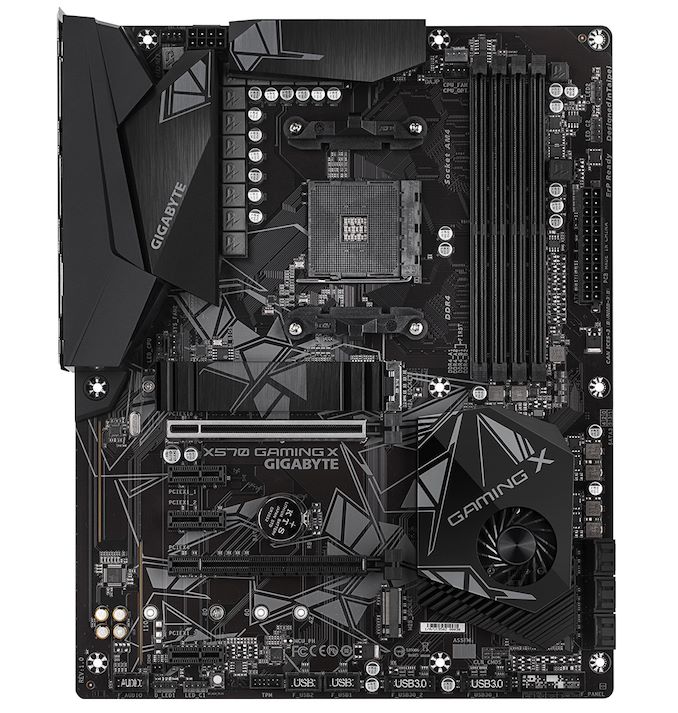The AMD X570 Motherboard Overview: Over 35+ Motherboards Analyzed
by Gavin Bonshor on July 9, 2019 8:00 AM ESTGIGABYTE X570 Gaming X
Currently at the bottom of GIGABYE's gaming-focused product stack is the X570 Gaming X. With a slightly lesser 10+2 power delivery when compared to the X570 Aorus Elite with a 12+2, the X570 Gaming X includes a cheaper Realtek ALC887 audio codec, a Realtek RTL8111H Gigabit NIC, and two PCIe 4.0 x4 M.2 slots. On the boards PCB itself is a very funky and unique black and grey theme with triangle shaped accents which extends over the PCB onto the heatsinks. The X570 chipset heatsink includes a cooling fan, while the board has four memory slots with support for DDR4-4000 memory with up to 128 GB.
On the lower half of the GIGABYTE X570 Gaming X is two full-length PCIe 4.0 slots which run at x16 and x16/x4. The top slot takes its lanes from the CPU, while the bottom full-length slot is locked at x4 from the X570 chipset, while there are also three PCIe 4.0 x1 slots; this means up to two-way AMD CrossFire multi-graphics card configurations can be used. For storage, the X570 Gaming X has two PCIe 4.0 x4 M.2 slots with the top slot coming with a heatsink, and a total of six SATA ports capable of support RAID 0, 1, and 10 arrays. The X570 Gaming X uses a 10+2 power delivery which is driven by an ISL69147 PWM controller running at 5+2 and uses a single 8-pin 12 V ATX CPU power input to delivery power to the processor.
On the rear panel is a relatively basic set of input and outputs with no USB 3.1 G2 connectivity to speak of. What actually is there in terms of USB support is four USB 3.1 G1 Type-A and two USB 2.0 ports. There is a separate pair of PS/2 inputs for legacy keyboard and mice. Finishing off the rear panel on the GIGABYTE X570 Gaming X is a single HDMI video output for users looking to run a compatible Ryzen APU, three 3.5 mm audio jacks that are driven by a Realtek ALC887 HD audio codec, and a Realtek RTL8111H Gigabit controlled Ethernet port.
The GIGABYTE X570 Gaming X is its gaming inspired, but surprisingly natural looking entry model onto the X570 chipset. With an MSRP of $169, it sits as one of the cheapest X570 models at the launch of the Ryzen 3000 processors, and with a wallet-friendly feature set with everything needed to make use of PCIe 4.0, it's a viable option for entry-level users. The only glaring issue is that there is no USB 3.1 G2 ports at all on the rear panel, and other models from other vendors at the same entry-level price point does include some.












225 Comments
View All Comments
Supercell99 - Tuesday, July 9, 2019 - link
I also expected benchmarks and a naked woman serving me a beer.haukionkannel - Wednesday, July 10, 2019 - link
You did not get that? That is really strange... I was sure that that was the basic service in here!;)
Gastec - Wednesday, July 10, 2019 - link
I had a dream last night about a woman, she was serving me...benchmarks :)Duncan Macdonald - Tuesday, July 9, 2019 - link
Why is the DDR4 memory speed being shown as a feature of the chipset? The memory is directly driven by the CPU not the chipset and as such the memory speed is independent of the chipset.Dug - Tuesday, July 9, 2019 - link
The motherboard still has work to do and is what supports the faster speed memory. Just because the cpu allows it, doesn't mean it will work without the correct chipset.thomasg - Tuesday, July 9, 2019 - link
The chipset has nothing to do with it, it has no relation to RAM clock and is exclusively driven by the PCIe clock, which is unrelated.The mainboard itself has the traces and therefore the manufacturer is expected to provide appropriate timing sequences to load into the CPU, which again, is not done on the chipset.
There's no reason a mainboard manufacturer couldn't support faster RAM on any older, compatible board (provided they do a firmware update and the board is designed well enough), a chipset upgrade is not required.
Death666Angel - Wednesday, July 10, 2019 - link
"the board is designed well enough" There is the catch. It might be that Ryzen being the first of its kind meant that many 3xx boards were designed poorly.First test I've seen is TPUs R9 3900x on a ASUS Prime B350 Plus which they claim ran at 3200CL14, but only after setting it to 2666MHz first and letting it train the memory. But it's an encouraging result.
Dug - Tuesday, July 9, 2019 - link
I'm interested in seeing what coolers will fit on the mITX boards. Specifically ASRock X570 Phantom Gaming-ITX TB3.It looks like some of these boards might be limited due to high heatsinks and fans on the motherboards.
Mikewind Dale - Tuesday, July 9, 2019 - link
Could we please have a comparison table? 35 pages is too many read. It would be useful to have a comparison table so that I can narrow down the several motherboards I am interested in, and then compare their prices.halcyon - Tuesday, July 9, 2019 - link
A summary table of features would indeed be very helpful. Way too many boards and pages...